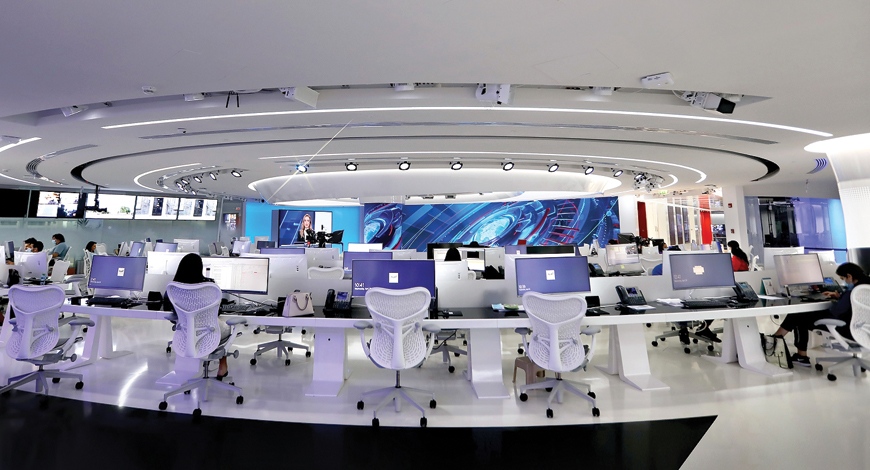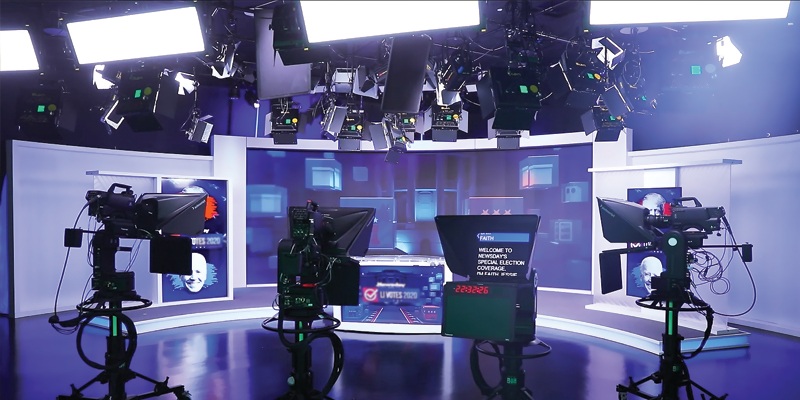BCS Stories
The pandemic-driven newsroom evolution

Television news has a long history of evolving—from the days when stories in the field were shot on film through electronic newsgathering to wireless network contribution of live and finished packages. The same could be said of newsroom technologies—from reporters on manual typewriters through a newsroom computer system to laptops in the field connected via virtual private networks (VPNs) to the newsroom system.
Each of these news workflow transitions was gradual, giving journalists and their news organizations time to adapt and adopt that in many cases was years long.
However, in March 2020 the COVID-19 left newsrooms, like the rest of society, in a scramble to maintain a degree of normalcy while the pandemic surged and alternatives to long-established routines were deployed. Newsrooms and media organizations have had to make swift and seismic changes to cope with remote working, accelerating news cycles, and evolving audience needs.
Many newsrooms accelerated plans only under consideration prior to COVID-19 to a phase of rapid deployment, such as embedding journalists more deeply in their communities and reducing their presence in the newsroom, or virtualizing common news workflows in the cloud. In other instances, newsrooms turned to new tools, such as video conferencing apps, to replace newsroom meetings.
These changes and others, however, do not seem temporary—tied to some future all-clear signal from a health authority. Rather, COVID-19 appears to have acted as a catalyst for a transformation in workflows touching newsgathering, production, and presentation that will be felt for years to come.
The COVID-19 effect
Television broadcasters responded to the pandemic with steps to limit exposure and maintain operations. Crowded newsrooms in particular were susceptible to the virus, not only because of the proximity of staff but because of the risk that reporters and news photographers in the field, who are exposed daily to a constant stream of people, might return to the station with the virus. Further, the close confines of production control rooms and the proximity of anchors on a news set demanded change.
A common strategy was to direct as many staff as possible to leave the station, work remotely from home or elsewhere, and adjust the work patterns of those who remained to reduce the likelihood of exposure. Only those required to be physically present for on-air production stayed; the rest, including those working on packages and documentaries and media managers, were sent home to work.
While a dramatic step, directing staff to work remotely in the initial phase of the pandemic also set in motion a major rethink and retooling of news processes and workflows that promise to leave a lasting mark on how TV news is gathered, produced, and presented.
Also read – Dark cloud of COVID hovers over M&E sector
For some newsrooms COVID-19 served as a catalyst that accelerated adoption of planned changes aimed at improving the quality and growing the number of news stories produced for on-air and digital distribution. COVID moved newsrooms 5 years forward in a matter of 5 weeks. It forced change that was probably inevitable and necessary. It demanded change in how news is gathered, meetings are conducted, interviews done, stories edited and newscasts produced and anchored, he said.

Innovating with technology
Many of the technologies that newsrooms have leaned into more heavily were already available pre-pandemic. It was not necessarily about using new technologies, but about putting everything in place to use lots of different technologies. The focus for organizations was keeping lines of communication open with reporters, sources, and audiences, and ensuring each group could interact with the other effectively. Newsrooms also had to adapt to how other organizations distributed information. Newsgathering in the field, newsroom editorial processes, control room workflows, and news production quickly evolved.
The crucial role of cloud. To distribute digital content to multiple platforms, newsroom software and the content it manages has to be remotely accessible and modifiable over IP networks. Operating newsroom software over a secure, reliable corporate LAN is one thing; providing this same functionality to remote users via the insecure, unreliable web is quite another. Fortunately, companies were addressing this challenge before anyone had heard of COVID-19.
IP has been a driving force in companies’ product development for many years. Initially, the focus was on how IP and the cloud would replace broadcasters’ on-premises SDI infrastructure. This focus changed during the lockdowns, when remote users took charge of keeping broadcasters’ news and other programming on air.
While anyone can bring an on-premises editor into their house, it is the team collaboration, news production workflow and management of files that is problematic. There is simply no editorial process or metadata management in place. For any station pushed into a pandemic workaround, access to the cloud proved key as did a way of managing many reporters and editors in multiple locations.
Broadcasting companies saw a number of news customers asking for help to support their remote workforces and adjust their infrastructure so that it could support editing from home. Their answer to newsroom shutdowns was cloud-based solutions. Such solutions allowed news broadcasters to offload some of their teams to work on company-hosted infrastructure while being away from the physical newsroom. Some also used cloud-based solutions as extensions of their on-premise installations, to provide business continuity to reporters, producers, and editors.
Some solutions provide tools familiar to anyone familiar with working in a physical newsroom. This meant there was no additional training required to enable people to produce, edit, write scripts, and collaborate with their teams from their homes. In addition to concerns over bandwidth, security and licensing issues, working from home created another speedbump: how does a broadcaster handle team collaboration, news production workflow and management of files when a team is no longer in the same room?
Also read : News production adapts to remote trends
Broadcasters resorted to services which securely connected staff at home to on-premise media asset management systems. This gave journalists during the pandemic access to tools with which they could search the production system, collaborate with producers, and edit growing files. News organizations also tapped into new mobile applications which enable a remote reporter to connect to their newsroom with a mobile device and write scripts, upload content to the newsroom, and use the mobile device as a teleprompter.

The rapid increase in use of NRCS systems remotely has not been without its hiccups. Some news broadcasters have been tweaking their current products to better support remote production, while developing new products that take this capability even further. CGI pivoted during this period to ensure its products remain relevant in the work-from-home environment.
The importance of staying connected is recognized, especially when many organizations have no choice, all while remaining cost-efficient and within budget. Among other things, this has meant establishing professional tools for delivering platform-agnostic content and establishing these within the current and future feature sets.
In the same vein, companies enhanced their solutions with the introduction of mobile apps and support for third-party NRCS. The new remote workflow capabilities give creative teams the capabilities and confidence to create more content in shorter timeframes regardless of location. This kind of flexibility is what news broadcasters want. What they are asking the companies to do is to build much more sophisticated editing products that can run in a web browser, where they could make something that is perfectly good to put on mainstream TV broadcast.
Some companies responded to current events by updating its browser-based tools. News broadcasters can already remotely schedule/edit incoming satellite and other feeds that are recorded at the station. In line with the trend to increased remote access, companies are adding more features to their timeline tools to be even more powerful from anywhere.
The future of camera control and automation. The most significant change in newsroom workflow is going to be in higher degrees of automation, and closer integration with other studio systems. Although established for a long time, news broadcasters do see further moves to full automation. Robotics need to be left to operate live on-air for long periods of time, perhaps with no operator or an operator carrying out several other critical roles.
Studio robotics will continue to get smarter, reducing the need for human intervention. Today’s studio robots can recall any saved shot, quickly and accurately, which eliminates the need for a camera operator to manually position the camera. Systems are emerging that can automatically account for slight movements by the talent or perhaps different talent from day to day. This is typically taken care of by the camera operator, whether through live adjustments while on-air, or by re-framing and updating the presets just before going on-air. If this can be done automatically, it further reduces the burden on the camera operator, potentially eliminating the need for a human camera operator during the production altogether.
This is particularly important in workflows that use production automation, where quite often the person responsible for running the automation system is also tasked with ensuring that the cameras are properly framed. As these automation systems become more adept at compensating not just small for movements for a subject sitting at a desk, but being able to create natural, smooth tracking shots for a subject that is moving around the set in an unscripted production, they will further reduce dependence on manual intervention, improving production quality and lowering operational expenses.
Newsgathering evolution. Even before the pandemic, many broadcasters, encouraged reporters and news photographers to spend more time reporting from the field and less time in the station. If they have the ability to shoot, edit story, edit script, and send it back remotely, often times, it was far better than driving in traffic back to the station and plugging in laptop to a docking station and then doing all that work.
The usability of today’s remote newsgathering tools and an emphasis on fast adaptation of workflows to meet the challenges presented by COVID-19 expedited development of new skills. Perhaps the biggest standout in newsgathering technology to emerge during the pandemic was video conferencing. Apps like Zoom, Microsoft Teams, Skype, and Slack offered journalists a convenient way to conduct face-to-face interviews without personally visiting newsmakers.
The convenience of scheduling a video conference interview versus an in-person equivalent makes Zoom and similar apps must-have technologies. From a workflow perspective, video conferencing apps also can help newsrooms unlock underused editorial resources. “Instead of having a photographer and reporter going to someone’s office at city hall to talk about the mayor’s economic plan, we can just schedule a Zoom call at 10 o’clock, have a producer do the interview, write the script, publish the interview for all of our digital platforms, and then pull a soundbite for the 5 o’clock and 6 o’clock newscast. That is really part of our newsroom of the future,” says Scott Livingston, vice president, Sinclair Broadcast Group.

Hyperlocal reporting. Some broadcasters saw the initial urgency to get reporters and news photographers out of the station and into the field as an opportunity to advance their long-term strategy of embedding journalists in the communities they cover. Coupled with this deeper community presence, technologies like laptops, small portable cameras and smartphone cameras, wireless connectivity, VPNs to connect back to the station, and cloud-enabled news workflows are making hyperlocal coverage a reality.
This strategy has already begun paying dividends. Not only has the quality of stories improved due to embedded reporters’ closer connection to their communities, but also these same journalists are producing 15 to 20 percent more content for on-air and digital distribution because they are spending more time reporting and less time commuting.
Tomorrow’s newsroom
If the last year has proven anything, it is that broadcasters are a resilient bunch. In March 2020, when newsroom stations began to be shuttered, news staff scrambled for ideas to pull off productions at home. Despite some hiccups, many stations across the world pulled off a successful, on-the-fly runaround because newsroom production technologies proved up to the task—the ability to pull in content, edit proxy material, upload graphics, cache locally—all with the final goal of covering breaking news faster even though they were not in the newsroom at all.
Consider the obstacles: security restrictions, VPN hurdles and the related problems of less-than-adequate broadband connections, licensing limitations, news workflow disruptions, and more. Despite all that, the work needed to be done.
Hence, like society at large, television news will be left with marks from the pandemic. Those effects will shape workflows and coverage far into the future. In certain respects, the pandemic served as a catalyst that accelerated adoption of long-planned strategies. Attitudes among many about how the cloud and other technologies enabling remote workflows changed rapidly. When considered at all prior to the pandemic, these tools were more frequently seen as something that would be nice to have.
However, work-from-home mandates largely changed that point of view. Suddenly, many news managers viewed the cloud—where virtualized alternatives for editing, graphics, and other newsroom workflows exist—as a necessity. Taken together, these changes point to a future for TV news operations—whether on air or online and on social media—that is far more flexible and better positioned to serve the news and information needs of local audience
In other respects, the pandemic forced reevaluation of newsroom institutions like the daily morning editorial meeting. Many broadcasters learned they could replace in-person planning meetings with video conferencing, freeing up thousands of hours annually that could be better spent reporting.
The restrictions on physical movement and contact have forced newsrooms and media organizations to find different ways of reaching people, both when gathering news and reporting it to their audiences.
In short, newsrooms have become more agile and responsive. As they get back to in-person operations they will incorporate these learnings into their future strategy.






You must be logged in to post a comment Login